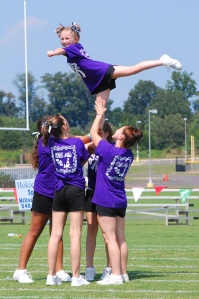First, I would recommend searching your local area for cheerleading tryout clinics. Some All Star Cheerleading gyms offer these clinics prior to tryout time for the local schools each year. Second, as you’re doing right now. Get online and learn about the sport. Make sure the websites you are reading are reputable. Whenever you are practicing or attempting any skills, always remember its important to remember safety. You must properly warm up your muscles and complete a full stretching session. This will avoid in unnecessary injuries.
Coaches look for cheerleaders that have great attitudes and serve as positive role models. Always arrive to tryouts on time and fully prepared. You should not be chewing gum, wearing jewelry of any kind, and your hair should be pulled back out of your face. Many will use the excuse, “I just got my ears pierced” or “I’m not allowed to take out these earrings.” These rules are set in place for safety reasons and also because organizations that oversee cheerleading in high schools mandate that things such as jewelry and chewing gum are a violation which could result in a penalty for your school. Wear soft shorts and a shirt that is neither too loose or too baggy. Always maintain your best attitude at practice and tryouts and keep talking to a minimum. Coaches are watching for these things during the pre-tryout practices.
For tryouts you will be evaluated on your motions and how well you execute these motions. Motions are used in cheerleading for cheers, chants, and dances. All cheerleaders must become familiar with basic cheerleading motions and practice. I recommend practicing your motions in front of a mirror, this is the easiest way to see any flaws and correct them. See the video tutorial below for an overview of basic arm motions. Motions can make or break your cheer, chant, or dance. Motions should be precise, sharp, and placed in the proper position. Some obvious flaws that judges will look for are bent wrists, thumbs sticking out, and overall “sloppy” motions. Motions are easy to fix and perfect with practice.
 Notice bent wrists with the arm motion called a, “high V.” Typically, new cheerleaders will start out this way, however, these motions are easily corrected when the cheerleader is instructed on how to correctly execute the motion. Also, practice placing the arm motion in front of a mirror several times until you repeatedly hit the motion correctly.
Notice bent wrists with the arm motion called a, “high V.” Typically, new cheerleaders will start out this way, however, these motions are easily corrected when the cheerleader is instructed on how to correctly execute the motion. Also, practice placing the arm motion in front of a mirror several times until you repeatedly hit the motion correctly.
 Notice bent wrists in the low V position. You can see the thumbs are not properly placed as well. The hands should be in a tight fist when executing arm motions.
Notice bent wrists in the low V position. You can see the thumbs are not properly placed as well. The hands should be in a tight fist when executing arm motions.
 This arm motion is a “T.” In this photo the T is not straight and the girls have bent wrists.
This arm motion is a “T.” In this photo the T is not straight and the girls have bent wrists.
 Here is an example of properly placed high V arm motions.
Here is an example of properly placed high V arm motions.
While practicing arm motions, keep these things in mind:
1. Start with a nice, strong stance. Your feet should be a little more than shoulder width apart; your hands should be in fists and resting on your hips in fists/blades by your side.
2. Keep your shoulders and hips squared forward
3. Keep your shoulders relaxed as you go through the motions (example: do not shrug shoulders as you raise arms to do a high V arm motion)
4. Do not over-extend arms
5. Check in the mirror for misplaced arm levels and placement. Also look for bent wrists and thumbs that are improperly placed. Remember, you hand should be squeezed in a tight fist.
6. Avoid Improper fist direction
7. Avoid bent or cocked wrists
Please see part 2 of So You Want to Cheer to learn more tips to prepare for cheerleading tryouts.
Cheers,
Coach Valarie






